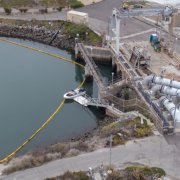(Editor’s note: As of Friday, October 8, the Carlsbad Desalination Plant continues operating at full production with no indication of oil in the feed water. As a precautionary measure, protective booms have been placed at several locations in the Aqua Hedionda Lagoon, including in front of the desalination plant intake).
Poseidon Water and the San Diego County Water Authority issued the following joint statement in response to emergency response efforts following the recent oil spill off the coast of Orange County. No oil has been detected by the plant’s monitoring system.
“The San Diego County Water Authority and Poseidon Water appreciate precautionary efforts by state emergency response crews to install a protective boom at the mouth of Agua Hedionda Lagoon, which provides intake water for the Claude “Bud” Lewis Carlsbad Desalination Plant. State agencies are also installing a second barrier near the plant intake.



